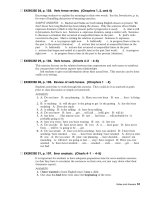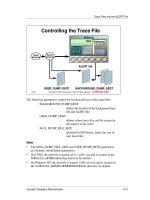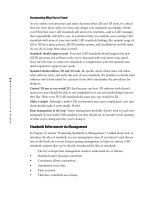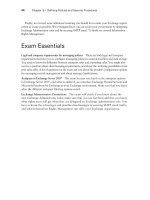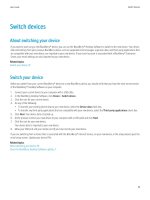Pro/ENGINEER Wildfire 3.0 Curriculum Guide phần 4 pps
Bạn đang xem bản rút gọn của tài liệu. Xem và tải ngay bản đầy đủ của tài liệu tại đây (205.63 KB, 12 trang )
Agenda
Day 1
Module 1 Introduction to Top-Down Design
Module 2 Top-Down Design Tools in Pro/ENGINEER
Module 3 Planning for Top-Down Design
Module 4 Creating the Security Camera Layout
Module 5 Creating the Security Camera Assembly Structure and Skeletons
Day 2
Module 5 Creating the Security Camera Assembly Structure and Skeletons (continued…)
Module 6 Camera Assembly Structure and Distribution of Tasks
Module 7 Arm and Base Assembly Design
Day 3
Module 8 The Camera Housing Design
Module 9 Completing the Camera Design
Module 10 Verification and Derivative Design
Pro/ENGINEER Mechanica Simulation using
Pro/ENGINEER Wildfire 3.0
Course Code TRN-1833-T
Course Length 5 Days
Overview
This course is designed for new users who want to test, validate, and optimize product
designs with Pro/ENGINEER Wildfire 3.0’s Mechanica module. Mechanica enables you to
simulate structural and thermal loads on product designs. You will also complete
comprehensive, hands-on lab exercises that simulate realistic analysis and design
optimization activities. Advanced topics such as combined mechanical and thermal analysis
techniques are also covered.
After completing the course, you will be able to run engineering analyses and optimizations
on your product design models.
Pro/FICIENCY assessments will be provided in order for you to assess your understanding of
the course materials. The assessment results will also identify the class topics that require
further review. At the end of the class, you will either take an assessment via your PTC
University account, or your instructor will provide training on how to do this after the class.
Prerequisites
• 3 months of Pro/ENGINEER Wildfire 3.0 experience or
• CADTrain Pro/ENGINEER Wildfire 3.0 Mechanica Primer
Audience
This course is intended for design engineers and mechanical designers. People in related
roles will also benefit from taking this course.
Topics
• Simulating Mechanical and Thermal Loads in Machine Parts
• Introduction to the Mechanica Simulation Process
• Modeling Geometry, Material Properties, Loads, and Constraints
• Running Static, Modal, and Thermal Analyses
• Reviewing and Interpreting Results
• Assigning Design Variables
• Running Design Sensitivity and Optimization Analyses
• Best Practices for Simulating Mechanical and Thermal Loads in Machine Parts
Agenda
Day 1
Module 1 Introduction to Structural and Thermal Simulation with Pro/ENGINEER Wildfire
3.0
Module 2 Optimizing Structural Designs using Pro/ENGINEER Mechanica 3.0
Module 3 Simplifying Designs Using Idealizations
Day 2
Module 4 Optimizing Models for Analysis
Module 5 Assigning Properties to Models
Module 6 Applying Constraints to Models
Module 7 Simulating Applied Loads on Models
Day 3
Module 8 Creating and Running Analyses
Module 9 Comparing MPA and SPA Results
Module 10 Evaluating Analysis Results
Day 4
Module 11 Running Sensitivity Studies
Module 12 Running Optimization Studies
Module 13 Applying Mechanica Analysis Concepts
Day 5
Module 13 Applying Mechanica Analysis Concepts (Cont’d)
Module 14 Projects
Cabling using Pro/ENGINEER Wildfire 3.0
Course Code TRN-1849-T
Course Length 3 Days
Overview
In this course, you will learn how to create 3-D electrical harnesses using Pro/ENGINEER
Wildfire 3.0. This includes using schematic diagrams created with Routed Systems Designer
6.0 to pass information into 3-D harness designs created within Pro/ENGINEER Wildfire 3.0.
You will also learn how to route electrical harnesses, create flattened harnesses for
manufacturing, and document harness designs by creating flattened harness drawings that
include customized BOM tables and wire list information.
At the end of each module, you will complete on-line learning assessments that reinforce
your understanding of the course topics. There is also a wrap-up assessment at the end of
the course.
After successfully completing the course, you will be able to create 3-D electrical harnesses
and associated manufacturing deliverables using Pro/ENGINEER Wildfire 3.0.
It is strongly recommended that cabling engineers attend this course and the Creating 2-D
Schematics with RSD 6.0 course. This will enable a full understanding of the complete
process and an understanding of how the configuration of deliverables from RSD such as
wiring diagrams provide essential input for creating electrical harness assemblies in
Pro/ENGINEER Wildfire 3.0.
Prerequisites
• Introduction to Pro/ENGINEER Wildfire 3.0.
• Creating Schematics using RSD 6.0 (Recommended)
Audience
This course is intended for engineers, involved in the 3-D routing of electrical cabling and
wire harnesses, and related roles. The topics in this course are also available as Web-based
training courses.
Topics
• Diagram and Harness Development Process Overview
• Creating Wiring Diagrams in Routed Systems Designer (RSD)
• Transferring RSD Information into Harness Designs
• Creating Electrical Harness Assembly Structures
• Routing Wires and Cables in Harness Designs
• Creating Flat Harnesses for Manufacturing
• Creating Harness Drawings
Agenda
Day 1
Module 1 Diagram and Harness Development Process Overview
Module 2 Creating Wiring Diagrams in RSD
Module 3 Creating Harness Assembly Structures
Day 2
Module 4 Establishing Logical References
Module 5 Creating Networks
Module 6 Routing Wires and Cables
Day 3
Module 7 Modifying Wire and Cable Routings
Module 8 Creating Flat Harnesses
Module 9 Documenting Harness Designs
Milling using Pro/ENGINEER Wildfire 3.0
Course Code TRN-1853-T
Course Length 5 Days
Overview
In this training course you will learn how to machine products using Pro/ENGINEER Wildfire
3.0 manufacturing tools. This course covers creating tool paths for milling machines.
During the course you will learn how to complete each phase of the manufacturing process.
You will start by creating the manufacturing model and setting up the manufacturing
environment. This will include configuring tools, fixtures, and machining operations. You will
also create milling sequences and post-process cutter location (CL) data to create machine
code.
After successfully completing the course, you will be able to create numerical control (NC)
programs for milling machines and post-process cutter location (CL) data to create machine
specific code.
At the end of each module, you will find a set of review questions to reinforce critical topics
from that module. Your instructor will discuss these with the class. At the end of the course,
you will find a course assessment in Pro/FICIENCY intended to evaluate your understanding
of the course as a whole.
Prerequisites
• Completion of TRN-WBT1893-S Introduction to Pro/ENGINEER Wildfire 3.0 – Fundamentals (Web
Based Training) or equivalent experience.
Audience
This course is intended for manufacturing engineers and NC machinists.
Topics
• Manufacturing process overview.
• Setting up the manufacturing environment.
• Creating and modifying milling sequences.
• Creating and modifying holemaking sequences.
• Using the process manager.
• Duplicating NC sequences.
• Correcting NC sequence failures.
• Post-processing cutter location (CL) data.
Agenda
Day 1
Module 1 Introduction to Manufacturing
Module 2 Creating Workpieces
Module 3 Creating Manufacturing Models
Module 4 Creating Manufacturing Operations
Day 2
Module 5 Creating Tools
Module 6 Using Manufacturing Parameters
Module 7 Creating Face Milling Sequences
Module 8 Creating Profile Milling Sequences
Day 3
Module 9 Creating Volume Milling Sequences
Module 10 Creating Local Milling Sequences
Module 11 Creating Surface Milling Sequences
Module 12 Creating Trajectory Milling Sequences
Day 4
Module 13 Creating Holemaking Sequences
Module 14 Creating Roughing, Re-roughing and Finishing Sequences
Module 15 Post Processing CL Data
Module 16 Using the Process Manager
Day 5
Module 17 Correcting Toolpath Failure
Module 18 Configuring the Manufacturing Environment
Module 19 Checking and Measuring Model Geometry
Module 20 Using Index Tables and Duplicating NC Sequences
Advanced Component Operations using
Pro/ENGINEER Wildfire 3.0
Course Code TRN-1859-T
Course Length 1 Day
Overview
In this course, you will learn how to perform advanced operations on design models. You
will learn how to add and remove material in components by using the merge operation.
You will also learn how to create new components using mirror and intersect operations.
Additionally, you will learn how to create features such as holes and cuts at the assembly
level.
Pro/FICIENCY assessments will be provided in order for you to assess your understanding of
the course materials. The assessment results will also identify the class topics that require
further review. At the end of the class, you will take an assessment using your PTC
University account.
After completing this course, you will be well-prepared to perform advanced operations to
create and modify components in Pro/ENGINEER Wildfire 3.0.
Duration
2 hours
Prerequisites
• Introduction to Pro/ENGINEER Wildfire 3.0
• Pro/ENGINEER Wildfire 3.0 Update from Pro/ENGINEER Wildfire 2.0
Audience
This course is intended for mechanical designers, design engineers, and related roles.
Topics
• Add and remove material from components by using the general merge operation.
• Create new components by using intersect and mirror operations.
• Create assembly level features.
Agenda
Day 1
Module 1 Advanced Component Operations
Creating Style and Warp Features using
Pro/ENGINEER Wildfire 3.0
Course Code TRN-1860-T
Course Length 1 Day
Overview
In this course, you will learn how to create sketch-based features with aesthetic and organic
shapes by using styled surface features. You will also learn how to alter the form and shape
of solids, quilts, facets, and curves by using warp features.
Pro/FICIENCY assessments will be provided in order for you to assess your understanding of
the course materials. The assessment results will also identify the class topics that require
further review. At the end of the class, you will take an assessment using your PTC
University account.
After completing this course, you will be well-prepared to create style and warp features
using Pro/ENGINEER Wildfire 3.0.
Duration
2 hours
Prerequisites
• Introduction to Pro/ENGINEER Wildfire 3.0
• Pro/ENGINEER Wildfire 3.0 Update from Pro/ENGINEER Wildfire 2.0
Audience
This course is intended for mechanical designers, design engineers, and related roles.
Topics
• Create style curves, surfaces and features
• Create warp features to alter design model geometry
Agenda
Day 1
Module 1 Creating Style and Warp Features
Analyzing and Optimizing Design Models with
Pro/ENGINEER Wildfire 3.0
Course Code TRN-1861-T
Course Length 1 Day
Overview
In this course, you will learn how to create various types of analyses including measuring
distances, calculating mass properties and interferences, and examining surface curvature
and continuity in design models. You will be able to save these analyses as features that
update along with changes to the design models.
Pro/FICIENCY assessments will be provided in order for you to assess your understanding of
the course materials. The assessment results will also identify the class topics that require
further review. At the end of the class, you will take an assessment using your PTC
University account.
After completing this course, you will be well-prepared to create analysis features and
create feasibility and optimization studies using Pro/ENGINEER Wildfire 3.0.
Duration
2 hours
Prerequisites
• Introduction to Pro/ENGINEER Wildfire 3.0
• Pro/ENGINEER Wildfire 3.0 Update from Pro/ENGINEER Wildfire 2.0
Audience
This course is intended for mechanical designers, design engineers, and related roles.
Topics
• Create various types of design model analyses
• Create analysis features
• Create feasibility and optimization studies
